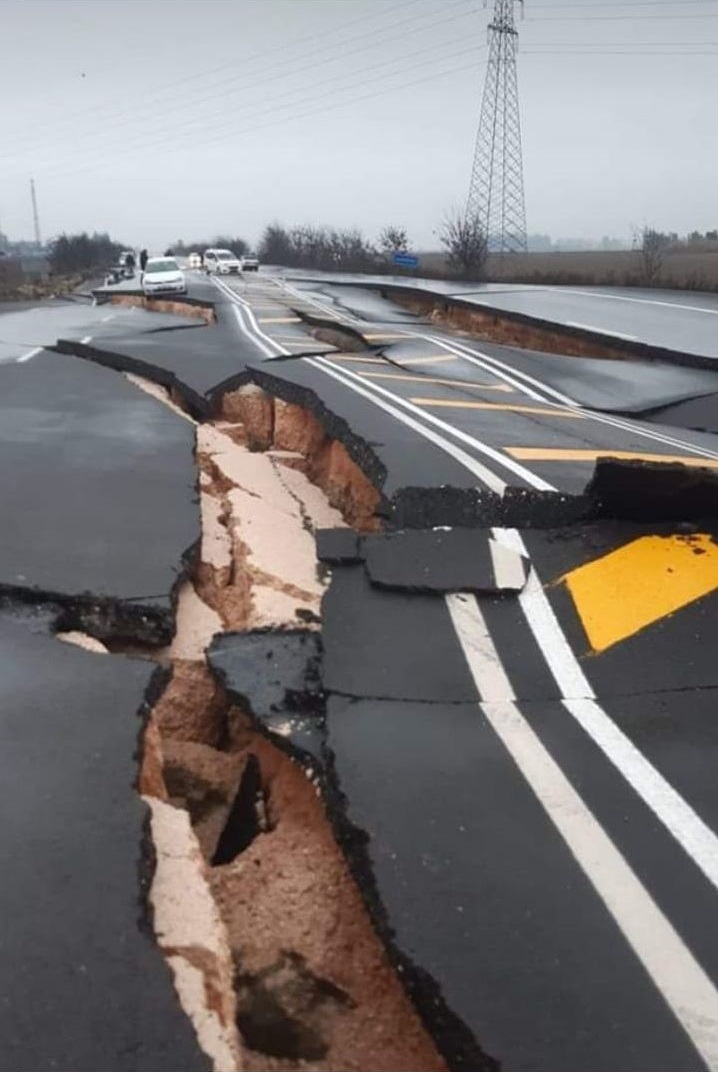Evolution of the crustal inner displacement deficit in a reference to Elazig earthquake series just before occurring the devastate Ekinozu-Nuradagi earthquakes (M7.5–7.8, 2023-02-06)
1 People's Friendship University of Russia, Moscow, Russia
2 Hacettepe University, Ankara, Turkey
3 Kocaeli University, Izmit, Turkey
4 Geophysical Center RAS, Moscow, Russia
5 Yuzuncu Yil University, Van, Turkey
Abstract

Over the past years, a group of Russian and Turkish geodesists and geophysicists has been studying the movements and deformations of the Earth’s crust in Eastern Anatolia (Turkey) in connection with the Elazig earthquake series (2010—2021) based on observational data. The results unexpectedly showed an area of deficit of internal displacements of the Earth’s crust in the area of destructive events. A brief description of the result obtained is presented below.
The mechanical system of material bodies is subjected to external and internal movements. In geophysics and seismology, much attention is paid to the identification of locked zones in the brittle Earth’s crust. The locked zone is a rigidity that prevents the internal movements of parts/blocks of the investigated area of the Earth’s crust. The distribution of internal motions of a section of the Earth’s crust is studied, in particular, using permanent GNSS observations. To identify locked/compacted zones, one can use the simplest characteristic — the deficit of internal displacements in the network of GNSS stations. In our studies, this characteristic is the modulus of the vector of horizontal internal displacements.
We obtain the internal displacements by subtracting their average value from the individual displacements of the stations retrieved in a single coordinate reference system
We determine the accumulation of internal displacements of GNSS stations in areas where strong earthquakes occur. We build frames of displacement deficit isolines for each day in a reference to the initial epoch and combine them into a single synoptic animation. The heuristic analysis of video allows us to see the accumulation of internal displacements and the localization of their deficit, that is, the locked zones.
Experience from of such studies has shown that the minimum of internal displacements accumulates before strong earthquakes in the area of their epicenter [Kaftan, 2021; Kaftan et al., 2021; 2022]. We consider this characteristic as a prognostic feature of the localization of a future earthquake.
The presented synoptic video demonstrates the evolution of the deficit of internal displacements in the area of occurrence of the series of strong earthquakes Elazig (Turkey) in the period 2009-2021. It can be seen that the first strong earthquake of 2010 with M6.1 occurred in the zone of internal displacement deficit (dark brown). Subsequently, internal displacements increased at this location which was accompanied by the release and relaxation of elastic stresses. The area of internal displacement deficiency has shifted in two directions to the southwest and northwest along the distribution of North Anatolian Fault Zone (NAFZ) and East Anatolian Fault Zone (EAFZ). Subsequently, four moderate earthquakes with M~5 occurred in these areas, and two of them which occurred southeast of the EAFZ, caused an increase in the mobility of the Earth’s crust at the epicenter of the strong earthquake in 2020 with M7.1. The 2020 Elazig earthquake occurred in the zone of accumulated displacements at a level of 5-6 cm and was accompanied by a co-seismic displacement of more than 10 cm, which later increased to 13 cm. The 2020 Bingol earthquake sequence also occurred in the mobile zone. In the following period, the entire study area was subjected to accumulated displacements of at least 5 cm. This indicates the release of elastic pre-seismic stresses in the entire relaxed region.
After the completion of these studies, the strongest devastating Ekinozu-Nurdagi earthquakes (M7.5-7.8, 2023-02-06) occurred in the EAFZ zone, accompanied by strong aftershocks. As shown in the last frame of the synoptic animation, the devastating series of earthquakes occurred in the area with the largest displacement deficit. This extreme dark brown area is visible in the southwestern part of the last frames about five years before the event.

Figure1. Areas of internal displacement deficiency formed before the Elazig earthquake (a) and the devastating Ekinozu-Nuradagi earthquakes (b). Red stars — strong Elazig earthquake epicenters. White stars — devastating Ekinozu-Nuradagi earthquake epicenters. Magenta arrows — horizontal displacement vectors. NAFZ & EAFZ — North and East Anatolian Fault Zones. KTJ – Karliova Triple Junction.
Acknowledgment. We thank the Prof. Dr. Emin Ulugergerli for providing the photo.
Database creation date: 2023; Publication date: February 2023
Contributor:
Geophysical Center of the Russian Academy of Sciences, Moscow, Russia
Institution: Geophysical Center of the Russian Academy of Sciences, Moscow, Russia
Publisher: Geophysical Center of the Russian Academy of Sciences (GC RAS), Moscow, Russia (http://www.gcras.ru/eng/)
Data format: .mov (QuickTime File Format)
doi: 10.2205/ESDB-Ekinozu-Nurdagi-quakes
Citation: Dokukin P. A., M. A. Guvenaltin, T. S. Irmak, V. I. Kaftan, M. Toker (2023) Evolution of the crustal inner displacement deficit in a reference to Elazig earthquake series just before occurring the devastate Ekinozu-Nuradagi earthquakes (M7.5–7.8, 2023-02-06). ESDB repository, GCRAS, Moscow, https://doi.org/10.2205/ESDB-Ekinozu-Nurdagi-quakes
References:
- Kaftan V. I. An Analysis of Ground Movements and Deformations from 13-year GPS Observations before and during the July 2019 Ridgecrest, USA Earthquakes. Journal of Volcanology and Seismology. 2021. V. 15. No. 2. P. 97–106. DOI: 10.1134/S0742046321010115.
- Kaftan V.I., Kaftan I., Gök E. Crustal Movements and Deformations in Eastern Turkey in Connection with the Van Earthquake (October 23, 2011, Mw=7.2): Study from GPS Data // Izvestia, Physics of the Solid Earth. 2021. V. 57. No. 3. P. 30-44. DOI: 10.1134/S1069351321030071.
- Kaftan V.I., Tatarinov V.N., Shevchuk R.V. Long-term changes in crustal movements and deformations before and during the 2016 Kumamoto earthquake sequence. Geodynamics & Tectonophysics. 2022; 13(1). DOI: 10.5800/GT-2022-13-1-0570.
License:  This work is licensed under a Creative Commons Attribution-NonCommercial 4.0 International License.
This work is licensed under a Creative Commons Attribution-NonCommercial 4.0 International License.
URL for downloading: http://esdb.wdcb.ru/doi/2023/ESDB-Ekinozu-Nurdagi-quakes/Evolution_of_internal_displacement_deficit_in_a_reference_to_Elazig.mov
- Hits: 1337

